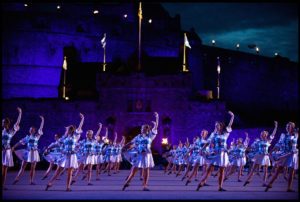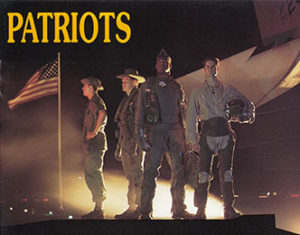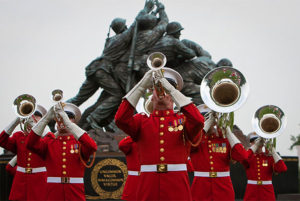Military performances celebrate pride and patriotism, culture and history, and the unifying power of music.
 On a Friday evening in August, the sun has set on Edinburgh, Scotland. About 8,800 audience members from all over the world sit anxiously in their seats, staring at the historic, 400-year-old Edinburgh Castle as they await the sounds of brass, woodwinds, pipes, and drums. The show they’re about to see is the Royal Edinburgh Military Tattoo, a central event of the Edinburgh Festival. Now entering its 67th season, the Tattoo showcases a variety of musicians from all over the world, including Scotland, England, Norway, China, New Zealand, the United States, and others.
On a Friday evening in August, the sun has set on Edinburgh, Scotland. About 8,800 audience members from all over the world sit anxiously in their seats, staring at the historic, 400-year-old Edinburgh Castle as they await the sounds of brass, woodwinds, pipes, and drums. The show they’re about to see is the Royal Edinburgh Military Tattoo, a central event of the Edinburgh Festival. Now entering its 67th season, the Tattoo showcases a variety of musicians from all over the world, including Scotland, England, Norway, China, New Zealand, the United States, and others.
Bringing together a variety of international performers illustrates what military tattoos are all about: showcasing a country’s esprit de corps, or pride, as well as camaraderie through music.
Music and the Military
The relationship between music and the military is both traditional and logistical. “The traditions that we hold onto in the military make us who we are,” says Joshua Miles, public relations chief and narrator for “The Commandant’s Own” U.S. Marine Drum and Bugle Corps. “They uphold discipline and keep us grounded. Music is an outlet to do that.”
 Music and drill as a part of military operations dates all the way back to ancient Rome. “In the early days, men at arms would attack as a horde,” says David Allfrey, chief executive and producer of the Royal Edinburgh Military Tattoo. “As we became more sophisticated, the Romans were the first to do foot drills on the battlefield with an economy of orders. They would use drums or horns to signal attacks.”
Music and drill as a part of military operations dates all the way back to ancient Rome. “In the early days, men at arms would attack as a horde,” says David Allfrey, chief executive and producer of the Royal Edinburgh Military Tattoo. “As we became more sophisticated, the Romans were the first to do foot drills on the battlefield with an economy of orders. They would use drums or horns to signal attacks.”
Back in the 17th century, the military referred to these signals with the Dutch phrase “doe den tap toe,” which translates to “turn off the tap,” meaning that innkeepers should stop serving beer and soldiers should return to their barracks. Because these signals came in the form of trumpet or drum calls, the “tap toe” portion of the phrase morphed into “tattoo,” which later came to mean a display of military music.
Currently, music’s importance in the military goes beyond discipline and battle signals. “We deploy, and morale can take a dip,” says Raymond Landon, musical resources specialist for the U.S. Air Force Heritage of America Band. “We can bolster that by doing what we do best.”
In general, today’s military tattoos use music and movement to stir patriotism, forge camaraderie between nations, and entertain crowds of spectators. Here are descriptions for some of the most famous tattoos worldwide.
Virginia International Tattoo
Norfolk, Virginia, is home to one of the United States’ largest military communities, with Navy, Coast Guard, Army, Marine Corps, and Air Force bases as well as North America’s only North Atlantic Treaty Organization (NATO) command. In 1997, the cities of Norfolk, Virginia Beach, and Williamsburg collaborated to create the Virginia Arts Festival, which puts on a variety of performances throughout the year. To celebrate the community’s military presence through the performing arts, the festival produces the Virginia International Tattoo, which performs several times every April.
 The Virginia International Tattoo features more than 1,500 performers. One of the tattoo’s signature performances is during the Norfolk NATO Festival. This past April, the tattoo featured bands from eight countries, ensembles from several U.S. military groups, as well as a Pipe Band Championship with groups from the United States, Canada, and United Kingdom.
The Virginia International Tattoo features more than 1,500 performers. One of the tattoo’s signature performances is during the Norfolk NATO Festival. This past April, the tattoo featured bands from eight countries, ensembles from several U.S. military groups, as well as a Pipe Band Championship with groups from the United States, Canada, and United Kingdom.
The Band of the Netherlands Mounted Arms Regiment brought humor to this year’s show by performing a comedic musical routine while riding bicycles. “Netherlands is a small, flat country, so in World War I, their cavalry was mounted on bicycles instead of horses,” says J. Scott Jackson, director and producer of the Virginia International Tattoo.
Members of the bicycle band dressed in historic World War uniforms and used custom-made one-handed instruments, keeping their other hand free to steer the bicycle. Another featured group at this year’s show was Top Secret Drum Corps from Switzerland.
The tattoo’s central purpose comes from the unifying power of music. One of the show’s main goals is to celebrate the relationship among NATO countries and U.S. allies around the world. “When you’ve come together through the arts, it’s a great bridge builder,” Jackson says. “Very often, music is a way to get a dialogue started. We all understand it and relate to it.”
The U.S. Air Force Langley Tattoo
From 1987 to 2008, the U.S. Air Force Heritage of America Band put on the Langley Tattoo, officially titled “The New Sound of Freedom,” which took place on an outdoor stage at Langley Air Force Base in Virginia. The show honored Air Force veterans and communicated the history and values of the Air Force by taking audience members on a musical journey through various military periods.
The Fifes and Drums of Colonial Williamsburg, a group dating back to the 1700s, opened the show, followed by the World War I era, which featured the Air Force’s Drill Team twirling period rifles. The World War II era paid tribute to former Air Force officer Glenn Miller with a medley of his compositions. The Vietnam War section brought some levity to the show as the musicians performed humorous Air Force tunes.
 Landon, who has been with the Air Force’s Heritage of America Band since 1984, first as a French horn player and then as a member of the technical staff, mentions two songs in particular: “Itazuke Tower,” a song about a pilot trying to convince the tower to let him land his aircraft, and “Our Bomber Flies 10,000 Miles,” a song where a pilot brags about the distance his bomber can go. “There’s a lot of humor in there,” Landon says.
Landon, who has been with the Air Force’s Heritage of America Band since 1984, first as a French horn player and then as a member of the technical staff, mentions two songs in particular: “Itazuke Tower,” a song about a pilot trying to convince the tower to let him land his aircraft, and “Our Bomber Flies 10,000 Miles,” a song where a pilot brags about the distance his bomber can go. “There’s a lot of humor in there,” Landon says.
The show would then see a significant shift in tone. “There was a really interesting tribute to pilots or navigators who gave the ultimate sacrifice,” Landon says.
As the band played “The Battle Hymn of the Republic,” a narrator would tell vignette stories about individual soldiers. The backlit stage would produce a cloud of fog from which soldiers dressed in period uniforms would emerge, producing a silhouette of those they were representing. “It was a really striking way of visualizing these people,” Landon says.
The tattoo then transitioned into its closing medley, including a bolder “Battle Hymn” and “The Air Force Hymn.” Several planes would fly over the audience, including an F-15 fighter jet that would turn 90 degrees and go straight up into the air at full power.
Following the flyovers, the band would play “Echo Taps,” then bring the Fifes and Drums back for a grand finale of “The Stars and Stripes Forever.”
After the 2008 season, the Langley Tattoo was discontinued due to decreased personnel at the base. “During the mid-2000s, there was a big military surge in Iraq and Afghanistan,” Landon says. “A greater number of people at our local installation were deploying.”
Fortunately, the end of the Langley Tattoo did not mean a decrease in performance opportunities for the Heritage of America Band. For the past two years, the band has performed at the Virginia International Tattoo. “We always find a way to replace the vacuum in our schedule,” Landon says.
The U.S. Marine Corps Ceremonies
Much like the Heritage of America Band, “The Commandant’s Own” U.S. Marine Drum and Bugle Corps knows how to balance a variety of musical performances. “We’re pretty versatile,” Miles says. “We do everything from military tattoos to exhibition at [Drum Corps International] championships.”
On Tuesday evenings in August, “The Commandant’s Own” performs its weekly Sunset Parade at the U.S. Marine Corps War Memorial statue in Arlington, Virginia. The parade’s music appeals to a wide range of audience members, with its mix of traditional and popular music. “We play everything from Sousa to Sinatra,” Miles says. “We played ‘Uptown Funk’ last year. This year, we have a medley from Journey.”
Despite the parade’s diverse selections, some customary music is crucial to the performance. “We always close with ‘The Stars and Stripes Forever,’” Miles says. “We always will! It’s our tradition.”
The group also performs every Friday evening in the spring at Marine Barracks Washington. Starting at 8:45 p.m., “The President’s Own” U.S. Marine Band starts the concert, after which they march up and down the deck along with the U.S. Marine Drum and Bugle Corps. “This is more of your traditional military tattoo,” Miles says. “It’s the place to be on Friday nights in D.C.”
This concert often draws a large crowd of spectators, from representatives and heads of state to the general public. The show offers about 5,000 seats, which are packed every Friday. “Every president since John F. Kennedy has gone there at least once in their term, if not two or three times,” Miles says.
Miles mentions this concert’s diverse audience as a point of pride. “[There are] foreign dignitaries sitting in the center and school kids from Iowa on a field trip sitting right next to them,” he says. “It’s always received the same way: awe and appreciation, pride and patriotism.”
In addition to these performances, back in 2002, the U.S. Marine Drum and Bugle Corps also participated in the United Kingdom’s Royal Edinburgh Military Tattoo, which combines music from all over the world into one legendary show.
The Royal Edinburgh Military Tattoo
In 1950, a celebration of music and culture was just what the people of Edinburgh needed. “In the wake of the second World War, Edinburgh was in a ravaged state,” Allfrey says. “The Lord Provost decided the time had come to uplift the citizens of Edinburgh.”
The festival saw so much success that Edinburgh continued to host it every year. Throughout August, the tattoo performs every evening except on Sundays, including two performances on Saturdays, totaling about 25 shows.
Tickets for the Royal Edinburgh Military Tattoo have sold out for the past 17 consecutive years, and the profits serve an important purpose. “We’re a charity first and foremost,” Allfrey says.
Proceeds from the tattoo support arts organizations and armed service members who have been injured mentally or physically. Last year, the tattoo put 500,000 pounds toward the charity.
Another major goal of the tattoo is to unite different cultures through music. “I encourage a cultural component,” Allfrey says. “A military force should always represent its society.”
Each year, the show brings in 1,200 to 1,400 performers from all over the world. “At the heart of the show are pipes and drums from Scottish regiments,” Allfrey says.
The second staple of the tattoo includes musicians from the British military, including the Air Force, Navy, and Army bands. The show also features a group called The Pipers’ Trail, which comprises pipes and drums from a variety of countries, including Scotland, Chile, Australia, and the United States.
This year, the tattoo will feature a variety of acts including the United States Army Europe Band, the New Zealand Army Band, and His Majesty The King’s Guard from Norway. Last year, the tattoo featured the Military Band of the Chinese People’s Liberation Army. In years past, they’ve had performances by military bands from South Korea, Mongolia, and Brazil. “We scour the planet,” Allfrey says.
Naturally, this diverse group of performers tends to draw a diverse audience. About 35% of audience members come from outside of the United Kingdom. “Last year, we sold tickets to 89 different nationalities,” Allfrey says. “By the end of the evening, they’re all leaving as friends to sing ‘Auld Lang Syne,’ Very poignant end to the day.”
Famous Military Musicians
Famous band composers often have military ties. “Glenn Miller was a popular big band leader before he joined the Air Force,” says Raymond Landon, musical resources specialist for the U.S. Air Force Heritage of America Band. “John Philip Sousa was a military musician for nearly 20 years of his career, aside from being a civilian band leader. Some of his most important marches were written when he was in a military band.”
Sousa was a member of the U.S. Marine Corps and served as leader of the U.S. Marine Band. During that time, he wrote several of his famous marches, including “Semper Fidelis.”
Later in his life during World War I, Sousa became a lieutenant in the U.S. Naval Reserve and led the U.S. Navy Band at the Naval Station Great Lakes near Chicago. For this service, he received the World War I Victory Medal.


